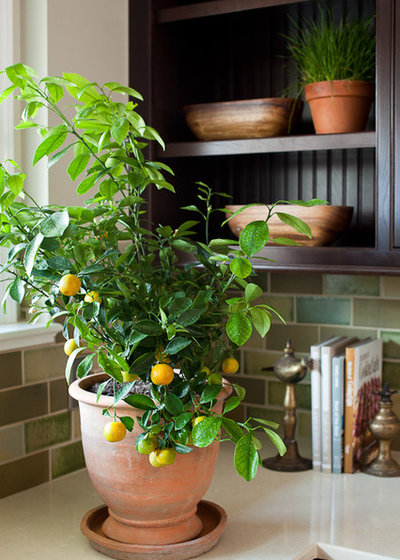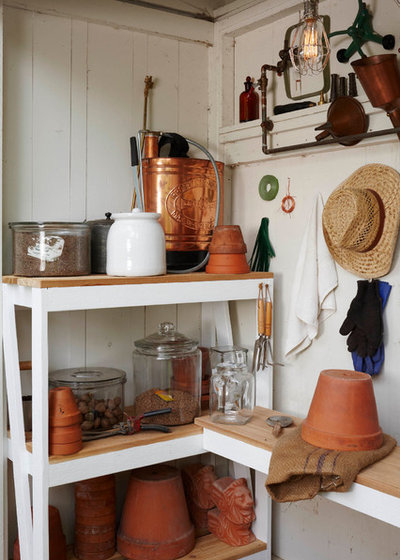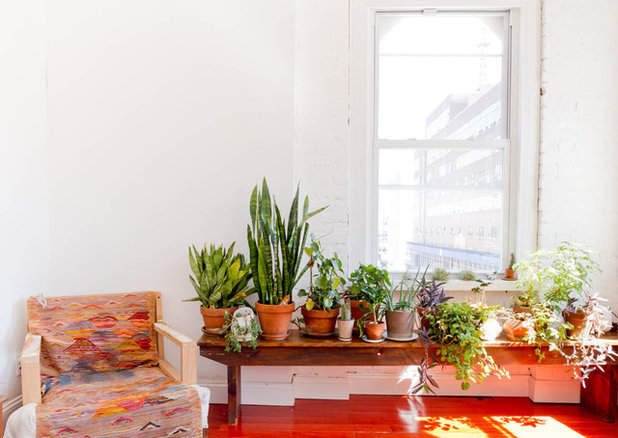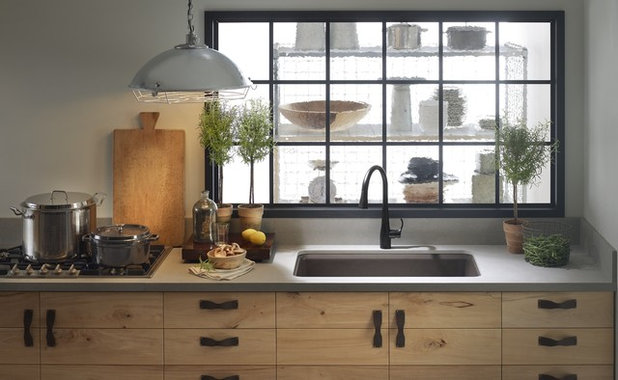Living in a cold climate where days get short and dark, and winter seems to drag on forever, can be disheartening. Why not take the edge off the chill by tending to an indoor garden? You can move in some outdoor potted plants that wouldn’t make it through winter otherwise, and add some new ones for a cheerful bounty of greenery that can carry you through to spring. Having more houseplants in winter when it’s battened down with the heater running will help clean the air indoors, and it will surely lift your spirits. Here are some tips for bringing plants indoors for winter and picking new plants to add to your winter garden, and some ideas for bigger additions … like a glorious sunroom or conservatory.

Lauren Liess Interiors
Which plants can you bring indoors? In climates with cold winters, you can successfully keep potted citrus trees, ferns, succulents and perennial herbs (like rosemary) alive by bringing them in once nighttime temperatures dip into the 50s. Some plants can stay out longer than others; check with your local nursery to get advice specific to your climate and the plants you keep.

Martha O'Hara Interiors
Conservatories, sunrooms and skylights. Ramp up winter sunlight indoors with one or all of these light-adding features. A dedicated sunroom or conservatory is the perfect spot for housing some types of overwintering plants — and with the addition of a fireplace and extra insulation, it could make a comfy spot for sitting and basking in the sunny glow, even on the coldest days. Skylights are another way to boost natural light — especially appealing where winter days are short and dark. Skylights also make it easier to keep sun-loving plants healthy and thriving.
10 Elements of the Perfect Sunroom

Rikki Snyder
Tropical wonders … in New England? Er, sort of. If living through another cold winter (wherever you are) is giving you the chills just thinking about it, consider adding a few lush warm-weather plants to your home. Sculptural succulents, delicate ferns and fragrant potted citrus trees in the house can almost make you forget it’s winter outside your door. Once the weather warms in the spring, you can move some of your plants outdoors to boost growth during the growing season.

Scott Weston Architecture Design PL
Make the indoor move easier. If you have enough time, move your outdoor potted plants to a shadier area of the yard or patio a week or two before you plan to bring them in. This will give the plants a chance to acclimate to lower light conditions before they come all the way indoors. If you are buying a citrus tree or other large potted plant now, invest in a plant stand on casters — rolling is
so much easier than lifting.

Scott Edwards Architecture
Prepare your indoor space. Plants that need full sun outdoors will be the most difficult to keep happy inside. Make room for your full-sun plants near a south-facing window for maximum sunlight. Partial-sun plants can go in a room with east- or west-facing windows. If there is nowhere in your home that gets enough sun (and you are committed to keeping those plants), you can rig up a plant light to see them through the winter. All houseplants should be positioned away from drafty doors and windows, as well as heating vents and radiators.

Art | Harrison Interiors & Collection
Prepare your pots. Before bringing any outdoor plant in, it’s important to check the pot for signs of insects that may be tagging along. The most thorough way to do this is by submerging the entire thing in a tub of water — if there are bugs living in the soil, they should appear in the water after a few minutes. If that happens, you may want to repot your plant and change the potting soil before bringing it in. Don’t do this for succulents, however, since they prefer to stay dry.
Also spray your plants with a mild insecticidal soap a few days before bringing them in — look for one that is safe to use on organic gardens and around pets and kids; you don’t need anything too harsh for this job. In fact, some gardeners have luck using a simple solution of pure Ivory liquid soap and water. Make sure you spray the tops and bottoms of all of the leaves where bugs like to hang out.

The Interior Edge
Quarantine if possible. When you first bring your plants indoors, it’s best to keep them in a room away from other houseplants for at least a few days. This will give you a chance to check for signs of insects before they jump onto every other plant in the house. If they can’t be in a separate room, at least keep them at the opposite end of the room. Use your soapy spray on the plants again if you do see signs of bugs.

Rikki Snyder
Group plants together. A group of plants looks cheery on a winter’s day, but it does more than lift spirits — plants grouped together stay healthier and dry out less often than those kept apart. Try lining a windowsill with potted plants, set up a plant stand or group several small pots on a tray filled with gravel.

Kohler
Caring for plants in winter. Plants that have been brought indoors generally need less water in winter than they did when they were outside. Touch the soil before watering, and water only when the soil feels dry. If your house gets very dry in the winter with the heater on, you may need to add humidity to the air around some plants, especially citrus trees and ferns. You can use a humidifier or simply spritz them with plain water occasionally.
Tell us: Do you bring plants indoors for the winter? Any tips to share?





